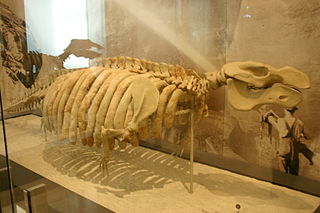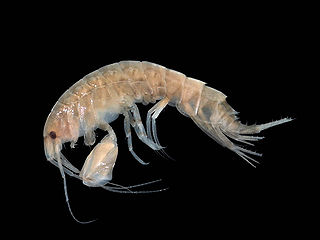The Devonian is a geologic period and system of the Paleozoic, spanning 60 million years from the end of the Silurian, 419.2 million years ago (Mya), to the beginning of the Carboniferous, 358.9 Mya. It is named after Devon, England, where rocks from this period were first studied.
The Permian is a geologic period and system which spans 47 million years from the end of the Carboniferous Period 298.9 million years ago (Mya), to the beginning of the Triassic period 251.902 Mya. It is the last period of the Paleozoic era; the following Triassic period belongs to the Mesozoic era. The concept of the Permian was introduced in 1841 by geologist Sir Roderick Murchison, who named it after the city of Perm.
The Silurian is a geologic period and system spanning 24.6 million years from the end of the Ordovician Period, at 443.8 million years ago (Mya), to the beginning of the Devonian Period, 419.2 Mya. As with other geologic periods, the rock beds that define the period's start and end are well identified, but the exact dates are uncertain by several million years. The base of the Silurian is set at a series of major Ordovician–Silurian extinction events when 60% of marine species were wiped out.

The gastropods, more commonly known as snails and slugs, belong to a large taxonomic class of invertebrates within the phylum Mollusca, called Gastropoda. This class comprises snails and slugs from saltwater, from freshwater, and from the land. There are many thousands of species of sea snails and slugs, as well as freshwater snails, freshwater limpets, and land snails and slugs.

Cephalochordata are small, segmented marine animals that possess elongated bodies with a notochord that extends the length of the body, extending from head to tail, persisting throughout the animal's life. Cephalochordates are represented in modern oceans by the Amphioxiformes. They are filter-feeders that consume microorganisms.
The Late Triassic is the third and final of three epochs of the Triassic Period in the geologic timescale. The Triassic-Jurassic extinction event began during this epoch and is one of the five major mass extinction events of the Earth. The corresponding series is known as the Upper Triassic. In Europe the epoch was called the Keuper, after a German lithostratigraphic group that has a roughly corresponding age. The Late Triassic spans the time between 237 Ma and 201.3 Ma. The Late Triassic is divided into the Carnian, Norian and Rhaetian ages.
The Emsian is one of three faunal stages in the Early Devonian epoch. It lasted from 407 ± 2.8 million years ago to 397.5 ± 2.7 million years ago. It was preceded by the Pragian stage and followed by the Eifelian stage.

Sirenia is the order of placental mammals which comprises modern "sea cows" and their extinct relatives. They are the only extant herbivorous marine mammals and the only group of herbivorous mammals to have become completely aquatic. Sirenians are thought to have a 50-million-year-old fossil record. They attained modest diversity during the Oligocene and Miocene, but have since declined as a result of climatic cooling, oceanographic changes, and human interference. Two genera and four species are extant: Trichechus, which includes the three species of manatee that live along the Atlantic coasts and in rivers and coastlines of the Americas and western Africa, and Dugong, which is found in the Indian and Pacific oceans.

Bramerton Pits is a 0.7-hectare (1.7-acre) geological Site of Special Scientific Interest north of the village of Bramerton in Norfolk on the southern banks of the River Yare. It is a Geological Conservation Review site.
Hunnebergia is an extinct genus from a well-known class of fossil marine arthropods, the trilobites. It lived during the early part of the Arenig stage of the Ordovician Period, a faunal stage which lasted from approximately 478 to 471 million years ago.
Arthricocephalus is an extinct genus from a well-known class of fossil marine arthropods, the trilobites. It lived during the later part of the Botomian stage, which lasted from approximately 524 to 518.5 million years ago. This faunal stage was part of the Cambrian Period.
Megapalaeolenus is an extinct genus from a well-known class of fossil marine arthropods, the trilobites. They lived during the later part of the Botomian stage, which lasted from approximately 524 to 518.5 million years ago. This faunal stage was part of the Cambrian Period.
Megalaspidella is an extinct genus from a well-known class of fossil marine arthropods, the trilobites. It lived during the later part of the Arenig stage of the Ordovician Period, approximately 478 to 471 million years ago.

Megalaspides is an extinct genus from a well-known class of fossil marine arthropods, the trilobites. It lived during the later part of the Arenig stage of the Ordovician Period, approximately 478 to 471 million years ago.

Callawayasaurus is a genus of plesiosaur from the family Elasmosauridae. When the first Callawayasaurus fossil was first discovered by Samuel Paul Welles in 1962, it was described as Alzadasaurus colombiensis before being moved into its current genus by Kenneth Carpenter in 1999.

Metaxytherium is an extinct genus of dugong that lived from the Miocene to the Pleistocene. Fossil remains have been found in Africa, Asia, Europe, North America, and South America.

The Botomian stage of the Early Cambrian epoch lasted from ca 524 to ca 517 million years ago. At the end of the Botomian stage there was a mass extinction that wiped out a high percentage of the organisms for which fossils were found. Organisms which produced small shelly fossils were almost exterminated.
The Paleocene or Palaeocene, the "old recent", is a geological epoch that lasted from about 66 to 56 million years ago. It is the first epoch of the Paleogene Period in the modern Cenozoic Era. As with many geologic periods, the strata that define the epoch's beginning and end are well identified, but the exact ages remain uncertain.

Crustaceans may pass through a number of larval and immature stages between hatching from their eggs and reaching their adult form. Each of the stages is separated by a moult, in which the hard exoskeleton is shed to allow the animal to grow. The larvae of crustaceans often bear little resemblance to the adult, and there are still cases where it is not known what larvae will grow into what adults. This is especially true of crustaceans which live as benthic adults, more so than where the larvae are planktonic and therefore more easily caught.

Crustaceans form a large, diverse arthropod taxon which includes such familiar animals as crabs, lobsters, crayfish, shrimp, krill, woodlice, and barnacles. The crustacean group is usually treated as a subphylum, and because of recent molecular studies it is now well accepted that the crustacean group is paraphyletic, and comprises all animals in the Pancrustacea clade other than hexapods. Some crustaceans are more closely related to insects and other hexapods than they are to certain other crustaceans.











